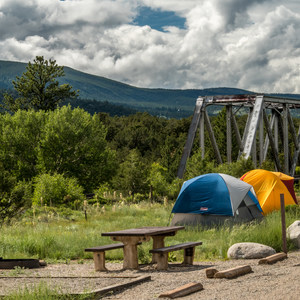Completed in 1987, the Colorado Trail stretches 485 magnificent miles from Denver to Durango. Along the way it meanders through high alpine mountains and valleys, offering a glimpse at some of the finest terrain Colorado has to offer. It traverses eight mountain ranges, six wilderness areas and stays above 10,000’ for the majority of the trail. Highlights include the Collegiate Range, where multiple 14ers are just off trail and can easily be climbed, and the San Juans, where the trail remains above tree line for days at a time and climbs to elevations of over 13,000’. There is also abundant wildlife along the Colorado Trail, ranging in size from small pika and marmot, to bear and moose.
The trail is divided into 28 different segments, each beginning at a trailhead accessible by vehicle. This accessibility is what makes the Colorado Trail special. Day hikers and section hikers can easily find their way to new segments of trail, while thru hikers can still enjoy a wild and rugged four to six week journey. Below is a description for Colorado Trail Collegiate West Segment 1.
Collegiate West Segment 1 begins at a seemingly random place on the south side of Twin Lakes. This junction marks the spot where Colorado Trail thru hikers must decide whether they are going to take the Collegiate East or Collegiate West route. I’d personally recommended the Collegiate West as it leads through more stunning mountain terrain than the east route.
To begin Segment 1 continue straight as the trail stays near the lakes for a while. You’ll then turn left at a well marked junction and begin the brutal climb up to Hope Pass. The trail gains 3,200 feet of elevation in less than 4 miles. The initial mile is arguably the worst as it climbs up a steep, rocky trail.
Things seem to mellow out a bit as you continue, but it is still a steep climb. You’ll eventually break above treeline and be able to see the pass where you are headed. To the right of the pass is namesake Mount Hope, at an elevation of 13,940 feet.
Continue on until you finally reach the pass. The views from here are absolutely stunning. The Collegiate Peaks lay spread out in front of you, including 14ers Huron and Missouri. For southbound Colorado Trail hikers this is certainly the most impressive view of the trail thus far.
You’ll then descend some sweeping switchbacks and drop down to the valley below. The descent is steady and will work whatever leg muscles the ascent didn’t!
You’ll finally reach the bottom, pass through some aspens, and come to a junction that’ll take you down to the Sheep Gulch Trailhead. This marks the end of Collegiate West Segment 1.
































Comments
Sign In and share them.